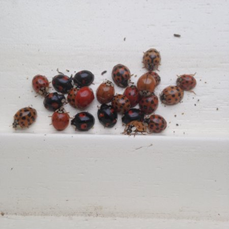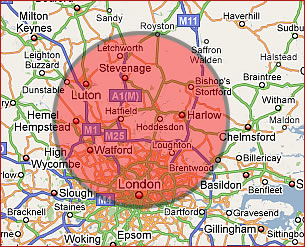Harlequin Ladybird
David can help reduce harlequin ladybird activity in your home. Please study the following information first to be better advised of the options available. You can arrange your detailed inspection and quotation by calling David today on Freephone 0800 118 2101 or 07761 373 060.
Harlequin ladybird (harmonia axyridis)
This species has a habit of invading our homes and outbuildings with the onset of late autumn as it searches for somewhere sheltered to over winter. Many people consider such clustering invasions in window frames and upper corners of rooms as nesting sites of the insect but it is nothing more than a chosen point of refuge.
Resolving such annual invasions on a permanent basis can prove extremely challenging for many reasons so let us first take a brief overview of the species and decide on an appropriate course of action.
Brief species overview:
The harlequin ladybird gets its name through the vastly different spectrum of colours it presents itself. Colours range from almost completely black to yellow, red and orange with different shades of these colours in between. Most exhibit two or more black spots with black specimens usually displaying two or more red or yellow spots. Some have no spotting at all.
Though sometimes similar in appearance to our own native ladybird this particular species is a highly invasive coccinellid beetle that first became apparent on our shores back in 2004. It originates from Eastern Asia but was subsequently introduced into the United States and other countries due to its natural predation on aphids and other crop pests. The species is now found almost worldwide in temperate climates and has now invaded a good portion of Southern Britain and beyond.
Harlequin ladybirds live and breed on plants and shrubs in our gardens and the countryside where the rather prehistoric looking spiny black and orange larvae feed ferociously on many of our native insect life forms.
Females lay clusters of eggs during peak summer and newly developed adult beetles emerge during August. Numbers can swell quite dramatically during this latter part of summer.
With the onset of autumn the species seeks a more sheltered environment as it prepares to overwinter. It is during this period and again in spring that migration habits of the insect start to bring it into conflict with humans.
Huge numbers of harlequins can congregate on warm, south facing walls in September and October and as temperature continue to drop finally work their way into our homes as mentioned previously.
How to control Harlequin Ladybirds in the home
Dealing with harlequin ladybirds in their breeding environment is out of the question. Not only is the wide outdoors too vast it is also home to every other source of wildlife which might be seriously harmed by any such proposal.
Improving the fit of window frames and doors and installing draught excluder can help but contrary to this I have seen brand new high quality fitments still suffering with the ingress of ladybirds. Covering airbricks with fine wire mesh and sealing off gaps and holes round frames, plumbing and cable runs to outside walls will all help at preventing entry. Washing down areas where the insects congregate regularly with a detergent will also assist by removing pheromones left by previous generations.
Applying a good quality residual insecticide (professional) at the right time of year to potential overwintering sites will put paid to any specimens that seek refuge in such areas. Results however can be mixed due to outside influences such as heat, humidity and weather conditions affecting the product used. This application also becomes an annual procedure with associated costs?
An alternative means of control is to vacuum any individuals as and when they arrive. Care should be taken however if dealing with large numbers as the insects secrete a pungent brown fluid from leg joints as part of a defence mechanism. This fluid will stain any furnishings it comes into contact with. Dispose of used vacuum bags or clean bag less cleaners on completion.
Scientists are still working on alternative means of deterring this species from our homes which includes the use of pheromones (a targeted scent) so watch this space for any updates. In the meantime we may have to rely on the insects natural predators coupled with preventative measures as above to alleviate the situation. I regret that harlequin ladybirds look like being here to stay!






